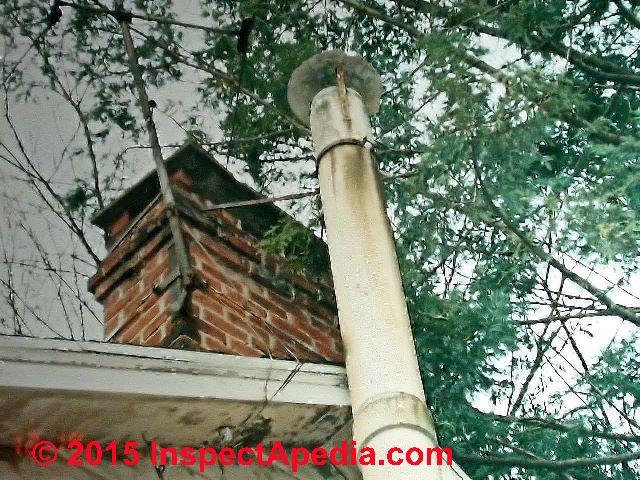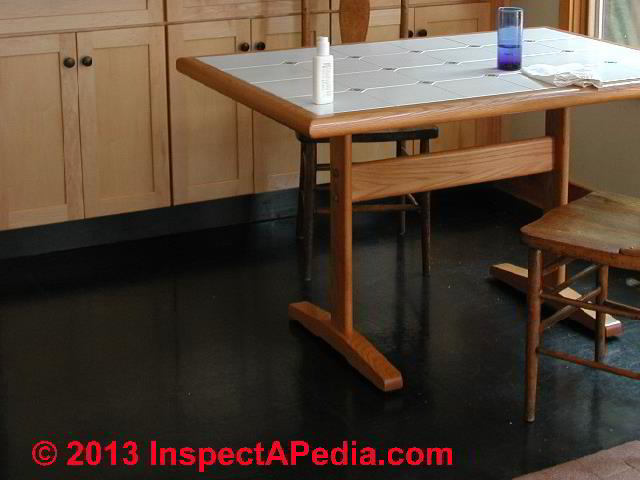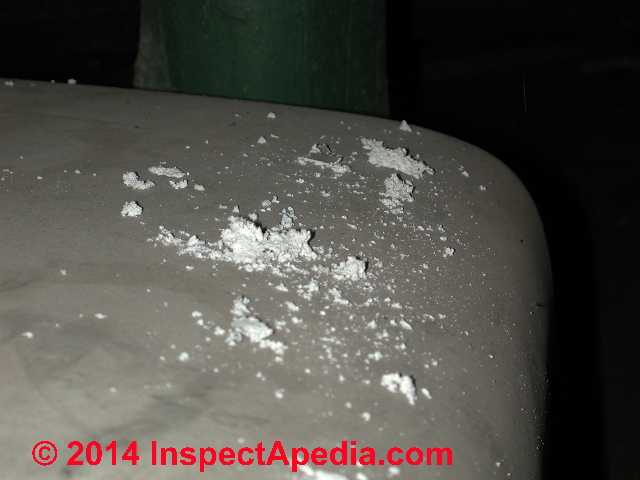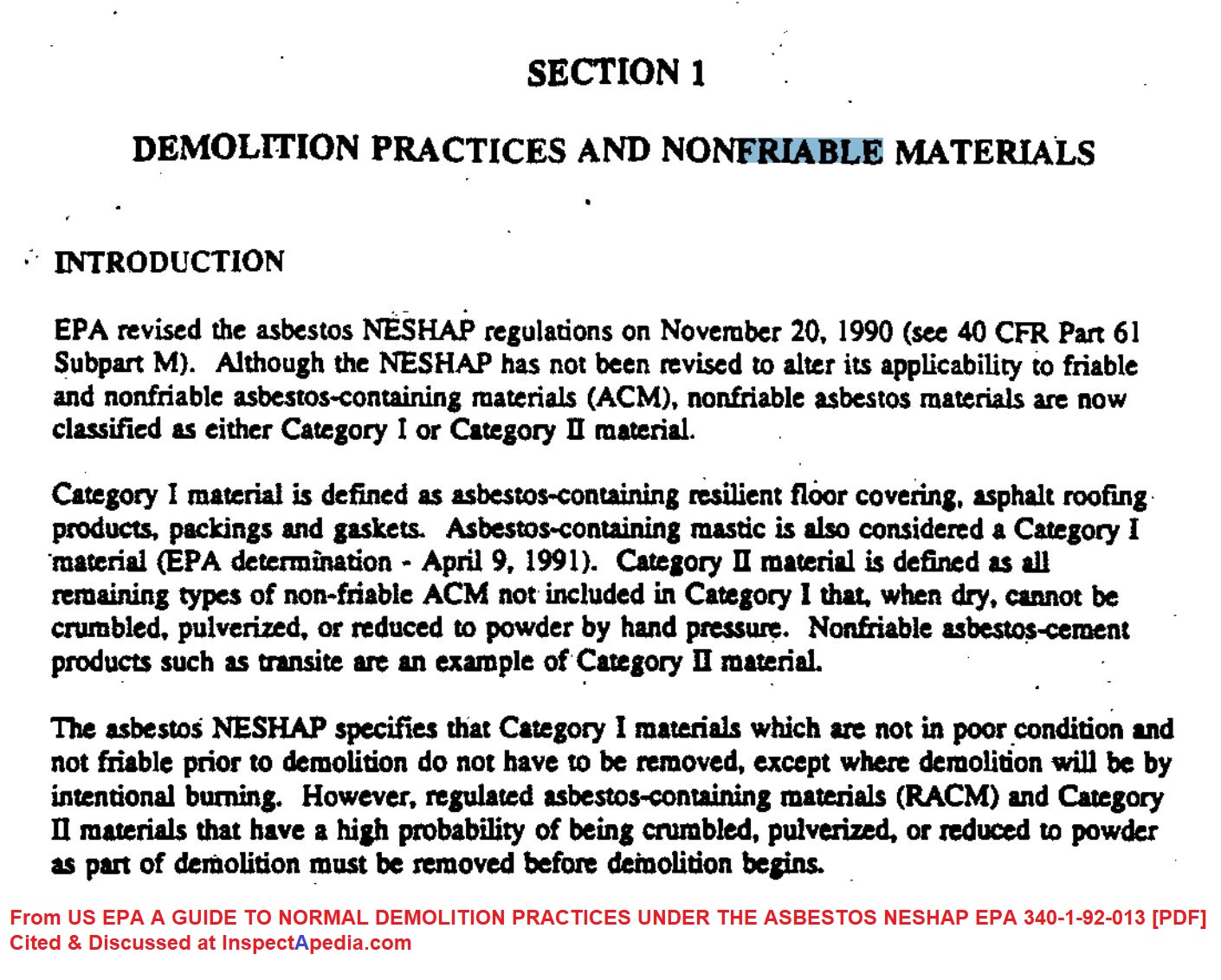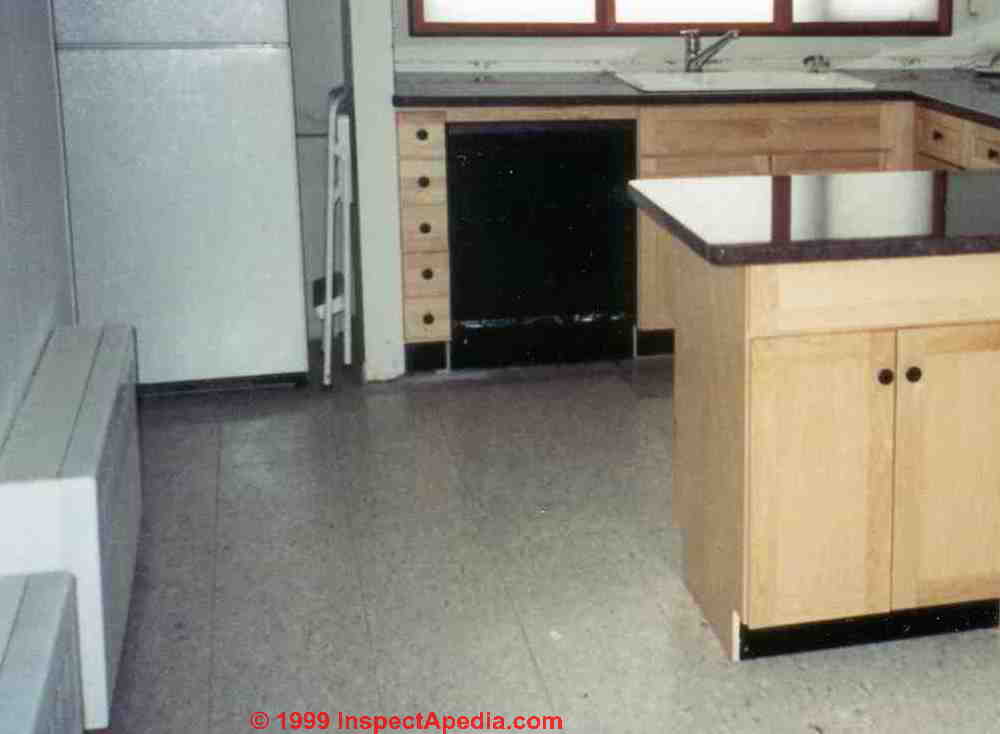 Safely Leave Asbestos-Containing Materials In Place
Safely Leave Asbestos-Containing Materials In Place
When can asbestos-containing materials be left alone?
When should asbestos-containing materials be removed?
Use of encapsulant paints or coverings for asbestos
- POST a QUESTION or COMMENT On how to minimize the risk of asbestos contamination in a building due to the presence of asbestos-containing floor tiles or asbestos-suspect floor tile coverings
Strategies for leaving asbestos-containing materials such as flooring, siding, roofing, or pipe insulation safely in place in or on a building.
Here we explain that where asbestos-containing materials are un-damaged and un-disturbed, usually they can and should be left in place: an approach that is both safe and economical.
Exceptions to that guide include some buildings such as schools where regulations require removal of asbestos materials.
Page top photo: vinyl asbestos floor tiles in the kitchen of a 1970's home - before the author painted over the tiles with black epoxy floor paint in 1999.
InspectAPedia tolerates no conflicts of interest. We have no relationship with advertisers, products, or services discussed at this website.
- Daniel Friedman, Publisher/Editor/Author - See WHO ARE WE?
When & How to Safely Leave Asbestos-Containing Materials in Place
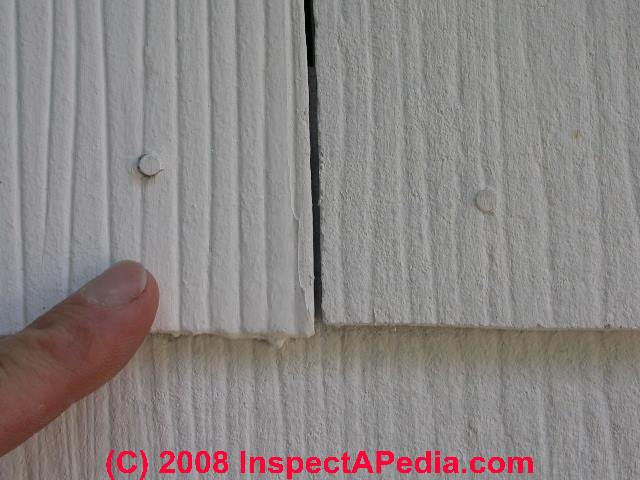 In this article we give examples of asbestos-containing or asbestos-suspect materials in buildings that can and should be left alone, in place, perhaps with a coating or encapsulant, and we give for comparison examples of asbestos products that should usually be removed.
In this article we give examples of asbestos-containing or asbestos-suspect materials in buildings that can and should be left alone, in place, perhaps with a coating or encapsulant, and we give for comparison examples of asbestos products that should usually be removed.
Asbestos is safe and legal to remain in homes or public buildings as long as the asbestos materials are in good condition and the asbestos can not be released into the air. - US EPA .
What these government experts are saying is that most asbestos-containing materials that are not friable and that are in good condition can and should be left alone, in place, perhaps covered by an encapsulant, or for flooring, covered by a layer of new flooring material.
Photo: asbestos-cement shingle siding on a 1920s home in Poughkeepsie, repaired by the author.
Asbestos cement siding or roofing is a hard cementious material. It is not friable - not easily made into dust likely to become airborne.
Article Contents
- DEFINITIONS OF FRIABLE vs NON-FRIABLE ASBESTOS, & of
CATEGORY I & CATEGORY II NON-FRIABLE ASBESTOS - ASBESTOS PRODUCTS TO BE LEFT IN PLACE VERSUS REMOVED - examples
- GUIDES for MANAGING ASBESTOS LEFT IN PLACE IN BUILDINGS - codes, regulations, procedures
...
Definition of Friable Asbestos Material
The US EPA in their "Asbestos NESHAP Adequately Wet Guidance" defines "friable asbestos material" as
Friable asbestos material is any material containing more than 1 percent asbestos as determined using Polarized Light Microscopy (PLM), that, when dry, can be crumbled, pulverized, or reduced to powder by hand pressure. - (EPA p, 3)
Watch out: many InspectApedia readers have told us that they are very frightened by the presence of asbestos-suspect materials in their home. It's normal to be nervous about threats over which we feel we have no control.
But as we warn at OTHER PEOPLE's MONEY, if you sound terrified you may also make your contractor or consultant so nervous that they will spend a lot of your money (not theirs) in an unnecessary expense.
Remember that the hazard from asbestos-containing floor tiles, asbestos cement roofing or siding, and even softer asbestos pipe insulation are not like something that's "radioactive" - that is to say that if the material is not damaged, if you avoid making a dusty mess by demolition, and more, if it the material can be covered and protected from damage, it is not harmful if left in place.
Definition of Category I Non-friable Asbestos-containing Materials
Photo above: an older asphalt shingle on the roof of a New York home. This shingle as well as its felt underlayment may contain asbestos - discussed in more detail
at ASPHALT ROOF MATERIAL ASBESTOS
Excerpt from the US EPA's NESHAP guidance for demolition of building materials that may contain asbestos:
Category I material is defined as asbestos-containing resilient floor covering, asphalt roofing products, packings and gaskets. Asbestos-containing mastic is also considered a Category I material.
Definition of Category II Non-friable Asbestos-containing Materials
Photo above: a transite or asbestos-cement chimney on a New York home - discussed in detail
at TRANSITE ASBESTOS CHIMNEYS, DUCTS, PIPES
Excerpt from the US EPA's NESHAP guidance for demolition of building materials that may contain asbestos:
Category II material is defined as all remaining types of non-friable ACM [Asbestos Containing Material] not included in Category I that, when dry, cannot be crumbled, pulverized, or reduced to powder by hand pressure.
Nonfriable asbestos-cement products such as transite are an example of Category II material.
How are these two categories of non-friable ACM applied to handling them in buildings? Continuing from the US EPA's NESHAP guidance:
The asbestos NESHAP specifies that Category I materials which are not in poor condition and not friable prior to demolition do not have to be removed, except where demolition will be by intentional burning.
However, regulated asbestos-containing materials (RACM) and Category II materials that have a high probability of being crumbled, pulverized, or reduced to powder as part of demolition must be removed before demolition begins.
Watch out: Asbestos cement or "transite" materials may shed harmful asbestos dust if power-washed. Those materials should not be disturbed by demolition or sawing, etc. except by a professional remediation expert. We warn about the power washing hazard
...
Asbestos Products to Leave in Place vs Remove
Photo above: the same building floor as shown at page top, after it was cleaned and then sealed with an expoxy floor paint. That floor has continued in safe daily use for over twenty-five years since the time that the author applied the sealant.
When are Asbestos-containing or Asbestos-suspect Materials Left in Place?
Category I non-friable asbestos-containing materials in good condition and undisturbed do not spontaneously emit harmful particles. These should be left in place.
We defined "Category I non-friable asbestos materials above on this page, followed by Category II - non-friable that are to be removed.
Photo above: vinyl asbestos floor tiles in the same 1970's kitchen as shown at the top of this page, but now twenty five years later, after having been painted over with black epoxy floor paint in 1999.
With this hard high-traffic-tolerant coating, the floor has been completely safe for more than two decades.
At ASBESTOS DEFINITION & COMPOSITION we explain that
Current best asbestos advice is to avoid the dust and mess of demolition of any asbestos-suspect product in a building if you can simply cover it with another material.
Conversely, both regulated asbestos containing materials (generally soft friable materials) as well as category II non-friable materials need to be addressed as a hazardous substance in buildings. That may mean removal in some cases (e.g. asbestos in the air path of an air handler) or removal prior to other building demolition work (both friable and category II non-friable materials).
Photo below: friable asbestos debris from damaged paper asbestos duct insulation. Unlike the intact, un-damaged asbestos floor tile case above, this is an unsafe situation deserving professional remediation.
When Should Asbestos-containing or Asbestos-suspect Products be Removed?
Some asbestos materials found in buildings should be removed - always by a professional with necessary expertise and in most jurisdictions, licensing. Examples include
- Friable asbestos containing products likely to be disturbed, such as asbestos pipe insulation in a location where it is likely to be struck or impacted
- Asbestos-containing products that are damaged or in poor condition such as pipe insulation or flooring - likely to release asbestos that may become airborne
- Asbestos products likely to be disturbed or that will be deliberately disturbed such as old drywall and joint compound on walls and ceilings during building remodeling or demolition
- Asbestos products that are in the air path in an HVAC system such as asbestos insulation inside of ductwork or inside of an air handler
- Asbestos-containing products that are highly friable or "dusty" likely to expose building occupants to asbestos, such as some (not all) vermiculite insulation that contains asbestos and that's located where it may be easily disturbed.
- Category II non-friable asbestos containing materials should be removed before the start of a building demolition project.
...
Guides to Managing Asbestos Left in Place in buildings
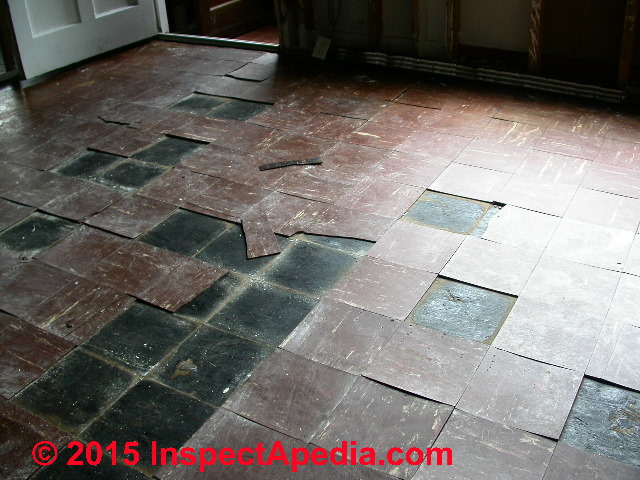 Watch out: if your asbestos-containing floor looks like the one in this photograph, sealing such a floor is not a reasonable approach.
Watch out: if your asbestos-containing floor looks like the one in this photograph, sealing such a floor is not a reasonable approach.
Removal of the flooring is required, and possibly the mastic adhesive needs to be removed as well.
The following U.S. EPA references include some on managing asbestos in place in buildings:
- EPA ASBESTOS REGULATIONS FOR SCHOOLS (the Asbestos Hazard Emergency Response Act, "AHERA") [PDF] (96 pp, 589k), web search 08/17/2010, original source: http://www.epa.gov/asbestos/pubs/2003pt763.pdf,
- EPA HOW to MANAGE ASBESTOS in SCHOOL BUILDINGS, AHERA Designated Person Self Study Guide, U.S. EPA 910-B-96-001, January 1996, web search 08/17/2010, original source: http://www.epa.gov/region2/ahera/e23.pdf
- EPA Guidance for Controlling Asbestos-Containing Materials in buildings, NIAST, National Institute on Abatement Sciences & Technology, [republishing EPA public documents] 1985 ed., Exposure Evaluation Division, Office of Toxic Substances, Office of Pesticides and Toxic Substances, U.S. Environmental Protection Agency, Washington,D.C. 20460
- EPA, MANAGING ASBESTOS in PLACE: A Building Owner's Guide to Operations and Maintenance Programs for Asbestos-Containing Materials ("Green Book"), web search 08/11/2010, original source: http://www.epa.gov/asbestos/pubs/management_in_place.html
How to Develop and Maintain a Building Asbestos Operations and Maintenance (O&M) Program, This information is designed to assist building owners and managers in understanding how to develop and maintain an operations and maintenance program for asbestos-containing materials in their buildings. - EPA, Monitoring Asbestos-Containing Material (ACM), U.S. EPA, web search 08/11/2010, original source: http://www.epa.gov/asbestos/pubs/section6.html - no longer on-line, quoting:
A visual re inspection of all ACM should be conducted at regular intervals as part of the O&M program to help ensure that any ACM damage or deterioration will be detected and corrective action taken.
- EPA, ASBESTOS IN YOUR HOME [PDF] - U.S. EPA, Exposure Evaluation Division, Office of Toxic Substances, Office of Pesticides and Toxic Substances, U.S. Environmental Protection Agency, Washington,D.C. 20460
- EPA's ASBESTOS REGULATIONS FOR SCHOOLS (the Asbestos Hazard Emergency Response Act, "AHERA") [PDF] (96 pp, 589k), web search 08/17/2010, original source: http://www.epa.gov/asbestos/pubs/2003pt763.pdf, require that an accredited inspector re inspect school buildings at least once every three years to reassess the condition of ACM.
The AHERA regulations for schools also require a routine surveillance check of ACM every six months to monitor the ACM's condition. This surveillance can be conducted by a trained school custodian or maintenance worker.
While only school buildings are required to have surveillance checks every six months, it is a good practice for other buildings with ACM. The asbestos program manager (APM) should establish appropriate surveillance and re inspection intervals, based on consultation with the building owner and any other qualified professionals involved in the O&M program.
EPA recommends a visual and physical evaluation of ACM during the re inspections to note the ACM's current condition and physical characteristics. Through this reinspection, it is possible to determine both the relative degree of damage and assess the likelihood of future fiber release.
Maintenance of a set of visual records (photos or video) of the ACM over time can be of great value during reinspections.
EPA recommends a visual and physical evaluation of ACM during the reinspections to note the ACM's current condition and physical characteristics. - EPA ASBESTOS IN YOUR HOME [PDF] (2010) U.S. EPA, Exposure Evaluation Division, Office of Toxic Substances, Office of Pesticides and Toxic Substances, U.S. Environmental Protection Agency, Washington,D.C. 20460
- NYC Health, ASBESTOS: WHAT YOU NEED TO KNOW [PDF] New York City, retrieved 2021/07/17 original source: https://www1.nyc.gov/assets/doh/downloads/pdf/edp/asbestos-faq.pdf
Excerpt: Asbestos, when intact, does not pose a risk to health. However, when asbestos-containing materials (ACMs) are damaged or disturbed, asbestos fibers can be released into the air and breathed in. [And that condition is unsafe - Ed.] - TCSA, Asbestos in buildings: Guidance for Service and Maintenance Personnel ("Custodial Brochure") (July 1985) - available by telephone from the TCSA
- TCSA Guidance for Controlling Asbestos Containing Material in buildings ("Purple Book") (June 1985) - available by telephone from the TCSA
- TCSA Fact Sheet/Press Release--EPA Releases Asbestos-in-Public-buildings Study and Recommendations to Congress: Extent and condition of asbestos containing materials in public and commercial buildings (February 1988) - available by telephone from the TCSA
- US CPSC ASBESTOS IN THE HOME [PDF] (2021) U.S. Consumer Product Safety Commission, Washington D.C., retrieved 2021/07/17 original source: https://www.cpsc.gov/safety-education/safety-guides/home/asbestos-home
Above: Except from EPA's Guide to Demolition Practices (for non-friable asbestos material cateogies and handling) cited below.
- US EPA A GUIDE TO NORMAL DEMOLITION PRACTICES UNDER THE ASBESTOS NESHAP EPA 340-1-92-013 [PDF] retrieved 2019/08/30
- US EPA ASBESTOS / NESHAP REGULATED ASBESTOS CONTAINING MATERIALS GUIDANCE EPA 340-1-90-018 [PDF] retrieved 2019/08/30
- US EPA ASBESTOS NESHAP ADEQUATELY WET GUIDANCE, EPA340/1-90-019, [PDF] December 1990, U.S. ENVIRONMENTAL PROTECTION AGENCY, Office of Air Quality Planning and Standards, Stationary Source Compliance Division, Washington, DC 20460, original web source: http://www.epa.gov/region04/air/asbestos/awet.htm
- US EPA GUIDANCE FOR CATASTROPHIC EMERGENCY SITUATIONS INVOLVING ASBESTOS [PDF] (2009)
Additional Asbestos Exposure Prevention Measures for Asbestos Hazards
- Supplemental Air Monitoring for Asbestos Hazards
As part of an O&M program, a carefully designed air monitoring program to detect airborne asbestos fibers in the building may provide useful supplemental information when conducted along with a comprehensive visual and physical ACM inspection and reinspection program.
For employees who are, or may reasonably be expected to be exposed to airborne concentrations of asbestos fibers above the permissible limits set by the Occupational Safety and Health Administration (OSHA), regulations require that the employer conduct both initial and periodic air sampling.
For more information about the OSHA exposure monitoring requirements, see the OSHA regulations at 29 CFR § 1910.1001(d) found at http://www.osha.gov/pls/oshaweb/owadisp.show_document?p_table=STANDARDS&p_id=9995If the ACM is currently in good condition, increases in airborne asbestos fiber levels at some later time may provide an early warning of deterioration or disturbance of the material. In that way, supplemental air monitoring can be a useful management tool.
If an owner chooses to use air monitoring in an "early warning" context, a knowledgeable and experienced individual should be consulted to design a proper sampling strategy. (See Useful Links for more information on air monitoring, found at http://www.epa.gov/asbestos/pubs/section10.html .)This air monitoring should supplement, not replace, physical and visual inspection. Visual inspection can recognize situations and anticipate future exposure (e.g., worsening water damage), whereas air monitoring can only detect a problem after it has occurred, and fibers have been released.
- Sampling Methods for Asbestos Hazards
Note that the collection of air samples for supplementary evaluation should not use aggressive air sampling methods. Aggressive sampling methods, in which air is deliberately disturbed or agitated by use of a leaf blower or fans, should only be used at the completion of an asbestos removal project inside the abatement containment area.
- Methods of Air Sampling Analysis for Asbestos Hazards - comparison of TEM & PCM Asbestos Testing
The most accurate and preferred method of analysis of air samples collected under an O&M program requires the use of transmission electron microscopy (TEM).
Phase contrast microscopy (PCM), which is commonly used for personal air sample analysis and as a screening tool for area air monitoring, cannot distinguish between asbestos fibers and other kinds of fibers which may be present in the air. PCM analysis also cannot detect thin asbestos fibers, and does not count short fibers.
TEM analysis is more expensive than PCM analysis.
However, the more accurate information on actual levels of airborne asbestos fibers that can be derived from TEM should be more beneficial to the building owner who elects to use supplemental air monitoring in the asbestos management program.
TEM analysis is most reliably performed by laboratories accredited by the National Institute of Standards and Technology - http://ts.nist.gov/Standards/scopes/temtm.htm- and who follow EPA’s quality assurance guidelines.
(SeeReferences or Citations , U.S. EPA, Dec. 1989, Transmission Electron Microscopy Asbestos Laboratories: Quality Assurance Guidelines. Washington, DC: EPA 560/5-90-002) found at http://ts.nist.gov/Standards/scopes/temtm.htm - Selecting a Lab to Test Samples for Asbestos
Selection of a reliable and experienced air monitoring firm and analytical laboratory is important, if the building owner elects to conduct supplemental air monitoring under the O&M program.
A consultant knowledgeable in air sampling and analysis protocols can be contacted for recommendations if the building owner or APM has limited knowledge in this area.
Contact your state asbestos regulatory agency (5 pp, 17k) (original source http://www.epa.gov/asbestos/pubs/statecontactsapril2009.pdf ) for information on how to find an accredited asbestos professional.
In addition, the National Institute for Standards and Technology (NIST) maintains a listing of accredited asbestos laboratories under the National Voluntary Laboratory Accreditation Program (NVLAP). You may call NIST at (301) 975-40
...
Reader Comments, Questions & Answers About The Article Above
Below you will find questions and answers previously posted on this page at its page bottom reader comment box.
Reader Q&A - also see RECOMMENDED ARTICLES & FAQs
What type of encapsulation primer/paint you think is best! Fiberlok?
Hello all, wondering what type of encapsulation primer/paint you think is best! I've seen quite a few online for sale, but having a hard time tracking any down. I see perfect prime but its not available in time for my needs.
On amazon I have found serpiex (sp) and a-b-c but they both seem to be made by the same company and I'm not sure if they are for flooring, or just insulation/soundproofing materials as stated in their literature.
Has anyone used a fiberlock brand? All this widom on here has been super helpful. On 2022-09-21 by Anonymous -
Reply by InspectApedia (mod)
@Anonymous,
Johnstone's A-B-C Primer, sold in the U.K. is a "high-performance everyday primer manufactured with acrylic resins.
The company says " It’s water-based, low odour formula means it can be used on a variety of surfaces such as plaster, cement, timber, melamine, masonry, interior stone and ceramic tiles." - this is not a primer designed specifically for asbestos encapsulation.
I found no asbestos encapsulant or sealant product under the "Serpiex" name.
Perfect Primer is an example of a suitable primer paint coating if you're going to then install a new layer of flooring over old asbestos-suspect floor tiles or over asbestos-suspect flooring mastic left on a surface after flooring has been removed.
There are quite a few other useful and recommended encapsulants for asbestos containing or suspect flooring, and other encapsulants and methods for other asbestos-containing materials such as pipe insulation.
Please take a look at the asbestos encapsulation and coating paints and sealers that we discuss in detail atASBESTOS ENCAPSULANTS & SEALERS - coatings, encapsulants, fiber release control for asbestos containing materials
...
Continue reading at ASBESTOS FLOORING LEFT IN PLACE or select a topic from the closely-related articles below, or see the complete ARTICLE INDEX.
Or see ASBESTOS FLOORING LEFT IN PLACE FAQs - questions & answers posted originally at this page.
Or see these
Recommended Articles
- ASBESTOS CEILING TILE IDENTIFICATION - 5 Easy Steps to tell if CEILING TILES are likely to contain asbestos
- ASBESTOS CEMENT PRODUCTS
- ASBESTOS in DRYWALL
- ASBESTOS DUCTS, HVAC
- ASBESTOS ENCAPSULANTS & SEALERS - sealant encapsulants & paints
- ASBESTOS & FIBER CEMENT ROOFING
- ASBESTOS FLOORING HAZARD LEVEL ASSESSMENT
- ASBESTOS FLOORING LEFT IN PLACE
- ASBESTOS IDENTIFICATION IN BUILDINGS - home
- ASBESTOS LEFT in PLACE in BUILDINGS - MANAGEMENT GUIDES - codes, regulations, procedures
- ASBESTOS MATERIAL REGULATIONS - home
- ASBESTOS PAPER DUCT INSULATION
- ASBESTOS PIPE INSULATION
- ASBESTOS REMOVAL, WETTING GUIDELINES
- ASBESTOS TESTING LAB LIST
- ASPHALT ROOF MATERIAL ASBESTOS
- DOES THIS MATERIAL CONTAIN ASBESTOS? - 5 easy questions to tell if a BUILDING MATERIAL probably contains asbestos -
- TRANSITE ASBESTOS CHIMNEYS, DUCTS, PIPES
- TRANSITE WATER & SEWER PIPE ASBESTOS RISK
- VERMICULITE INSULATION - home
Suggested citation for this web page
ASBESTOS LEFT in PLACE in BUILDINGS - MANAGEMENT GUIDES at InspectApedia.com - online encyclopedia of building & environmental inspection, testing, diagnosis, repair, & problem prevention advice.
Or see this
INDEX to RELATED ARTICLES: ARTICLE INDEX to ASBESTOS HAZARDS
Or use the SEARCH BOX found below to Ask a Question or Search InspectApedia
Ask a Question or Search InspectApedia
Questions & answers on how to minimize the risk of asbestos contamination in a building due to the presence of asbestos-containing floor tiles or asbestos-suspect floor tile coverings.
Try the search box just below, or if you prefer, post a question or comment in the Comments box below and we will respond promptly.
Search the InspectApedia website
Note: appearance of your Comment below may be delayed: if your comment contains an image, photograph, web link, or text that looks to the software as if it might be a web link, your posting will appear after it has been approved by a moderator. Apologies for the delay.
Only one image can be added per comment but you can post as many comments, and therefore images, as you like.
You will not receive a notification when a response to your question has been posted.
Please bookmark this page to make it easy for you to check back for our response.
IF above you see "Comment Form is loading comments..." then COMMENT BOX - countable.ca / bawkbox.com IS NOT WORKING.
In any case you are welcome to send an email directly to us at InspectApedia.com at editor@inspectApedia.com
We'll reply to you directly. Please help us help you by noting, in your email, the URL of the InspectApedia page where you wanted to comment.
Citations & References
In addition to any citations in the article above, a full list is available on request.
- "Asbestos in your home or at work," Forsyth County Environmental Affairs Department, Winston-Salem NC 12/08
- "Asbestos Floor Tile Removal", the University of Minnesota's advice on removing VAT (vinyl asbestos or asphalt asbestos floor tile) can be read in detail at www.health.state.mn.us/divs/eh/asbestos/floortile/index.html
- Resilient Floor Covering Institute, 1030 15th St. NW, suite 350, Washington D.C.
- ASBESTOS REGULATIONS FOR SCHOOLS (the Asbestos Hazard Emergency Response Act, "AHERA") [PDF] (96 pp, 589k), web search 08/17/2010, original source: http://www.epa.gov/asbestos/pubs/2003pt763.pdf,
- Asbestos Regulations: State asbestos regulatory agencies (5 pp, 17k) (original source http://www.epa.gov/asbestos/pubs/statecontactsapril2009.pdf ) for information on how to find an accredited asbestos professional.
- "Asbestos Floor Tile Removal Guide & Instructions - copy on file as Asbestos_Floor_Tile_Removal_MDH.pdf ] - ", Minnesota Department of Health, retrieved 12/7/2010, original source: http://www.health.state.mn.us/divs/eh/asbestos/floortile/index.html
- David Grudzinski, Advantage Home Inspections, is a professional home inspector in Cranston, RI. 02910. He can be reached at 401-935-6547, fax- 401-490-0607 or by email to contact/us@advantagehomeinspections.us 04/26/2009
- EPA Guidance for Controlling Asbestos-Containing Materials in buildings, NIAST, National Institute on Abatement Sciences & Technology, [republishing EPA public documents] 1985 ed., Exposure Evaluation Division, Office of Toxic Substances, Office of Pesticides and Toxic Substances, U.S. Environmental Protection Agency, Washington,D.C. 20460
- EVER WEAR TILE CO is currently (2009) in the Terrazzo, Tile, Marble, and Mosaic Work industry in Fallon, NV. 775) 423-6221. [We do not know the company history nor whether there is an association with EverWear vinyl asbestos floor tiles discussed in this article.]
- Asbestos Identification, Walter C.McCrone, McCrone Research Institute, Chicago, IL.1987 ISBN 0-904962-11-3. Dr. McCrone literally "wrote the book" on asbestos identification procedures which formed the basis for current work by asbestos identification laboratories.
- Stanton, .F., et al., National Bureau of Standards Special Publication 506: 143-151
- Pott, F., Staub-Reinhalf Luft 38, 486-490 (1978) cited by McCrone
- US EPA ASBESTOS NESHAP ADEQUATELY WET GUIDANCE, EPA340/1-90-019, [PDF] December 1990, U.S. ENVIRONMENTAL PROTECTION AGENCY, Office of Air Quality Planning and Standards, Stationary Source Compliance Division, Washington, DC 20460, original web source: http://www.epa.gov/region04/air/asbestos/awet.htm
- In addition to citations & references found in this article, see the research citations given at the end of the related articles found at our suggested
CONTINUE READING or RECOMMENDED ARTICLES.
- Carson, Dunlop & Associates Ltd., 120 Carlton Street Suite 407, Toronto ON M5A 4K2. Tel: (416) 964-9415 1-800-268-7070 Email: info@carsondunlop.com. Alan Carson is a past president of ASHI, the American Society of Home Inspectors.
Thanks to Alan Carson and Bob Dunlop, for permission for InspectAPedia to use text excerpts from The HOME REFERENCE BOOK - the Encyclopedia of Homes and to use illustrations from The ILLUSTRATED HOME .
Carson Dunlop Associates provides extensive home inspection education and report writing material. In gratitude we provide links to tsome Carson Dunlop Associates products and services.



